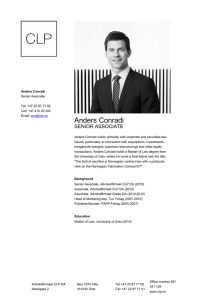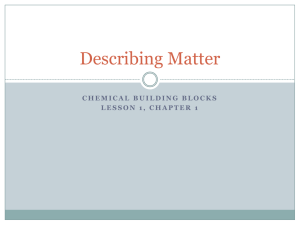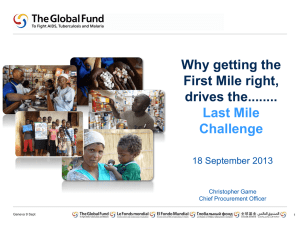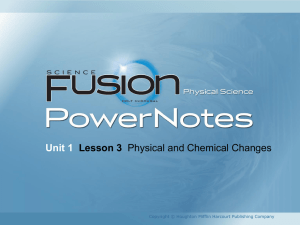REACH and CLP Downstream user overview - ECHA
advertisement
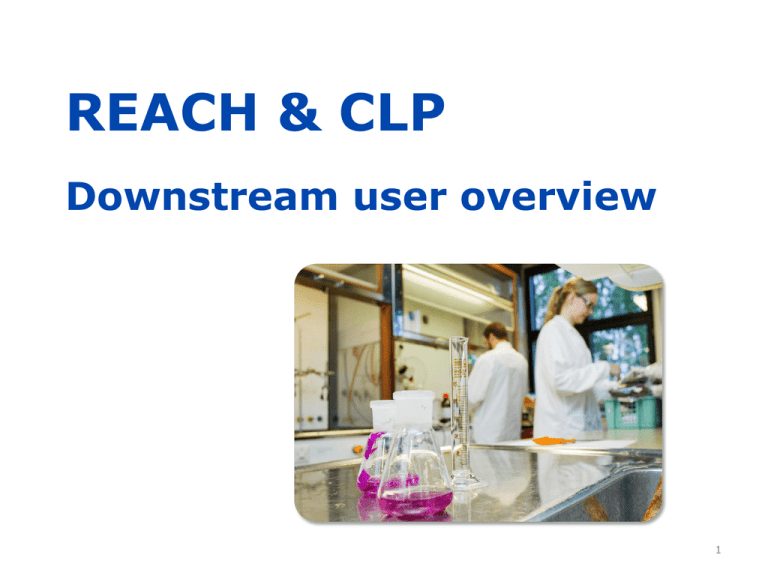
REACH & CLP Downstream user overview 1 Purpose of this presentation This presentation, with notes, was prepared by ECHA, the European Chemicals Agency, to assist you in preparing a presentation about REACH and CLP relating to downstream users. The intention is that you can select relevant slides and modify them as necessary to suit your audience, whether it is management, workers, environmental health and safety professionals, authorities etc. This presentation gives a brief overview of the main downstream user obligations, communication in the supply chain and the regulatory impact regarding substances of concern. Further presentations are planned, addressing the key aspects in more detail, so check the ECHA website for updates. We welcome your comments and suggestions at downstream_users@echa.europa.eu. Legal notice: The information contained in this presentation does not constitute legal advice and does not necessarily represent in legal terms the official position of the European Chemicals Agency. The European Chemicals Agency does not accept any liability with regard to the contents of this document. http://echa.europa.eu/downstream 2 Contents • Overview of legislative background • Downstream users under REACH and CLP • Communication in the supply chain • Substances of concern • Summary of main obligations under REACH and CLP 3 Overview of legislative background 4 Aims of REACH and CLP • Ensure a high level of protection of human health and the environment • Ensure promotion of alternative methods for assessment of hazards of substances • Ensure the free movement of chemicals • Enhance competitiveness and innovation 5 Key elements of REACH • Registration • Substances manufactured and imported into EEA are registered with ECHA Information for safe use is communicated in the supply chain Evaluation • • • Examination of registrant testing proposals Compliance check of registration dossiers Evaluation of substances Regulatory Risk Management • • • Authorisation Restriction Harmonised classification 6 Key elements of CLP Classify • Manufacturers, importers and downstream users classify substances and mixtures Label and package • Suppliers label and package them in accordance with CLP • Manufacturers, importers and downstream users notify substance to ECHA’s classification and labelling inventory Suppliers communicate information to Poison Centres Communicate • Harmonise • • CLP implements UN Globally Harmonised System The classification of certain substances is harmonised 7 Main roles of industry in REACH & CLP Manufacturer: manufactures a substance Downstream user: uses chemicals, e.g.: formulates, transfers or uses mixtures, produces articles Importer: imports chemicals from outside the EEA Distributor: stores or distributes chemicals A company may have multiple roles – the role depends on the activity being undertaken with a given substance 8 REACH/CLP and other EU chemicals legislation REACH and CLP work together with other EU/national legislation such as: • Chemical agents at work Directive 98/24/EC • Carcinogens or mutagens at work: Directive 2004/37/EC • Industrial emissions Directive 2010/75/EU • Biocidal Products Regulation 528/2012 9 Downstream users under REACH and CLP 10 Who is a downstream user under REACH/CLP? Companies or individuals • within the European Union / European Economic Area • who use a substance, either on its own or in a mixture • in industrial or professional activities 11 Formulators Formulators produce mixtures, which are usually supplied further downstream • Examples of mixtures: paints, lubricants, cleaning agents and adhesives …are downstream users 12 End users End users use substances or mixtures but do not supply them further downstream • Examples: users of chemicals reagents, coatings and inks, construction chemicals, metal working fluids, cleaning agents and adhesives …are downstream users 13 Producers of articles Producers of articles incorporate substances or mixtures into articles (both components and finished goods) • Examples: producers of textiles, vehicles, toys, jewellery and household appliances …are downstream users 14 Re-fillers, re-importers and certain importers Refiller: transfers substances or mixtures from one container to another (such as repackaging or rebranding) Re-importer: imports a substance, on their own or in a mixture, which was originally produced in the EU, and the substance was registered by someone in the same supply chain Importer with ‘only representative’ – imports a substance from outside the EU, but the non-EU supplier nominated an EU based ‘only representative’ …are downstream users 15 Who is NOT a downstream user under REACH/CLP? Distributors (including retailers) store and place chemicals on the market for third parties. REACH and CLP obligations are limited to forwarding information in the supply chain. Consumers do not have any obligations under REACH and CLP. …are NOT downstream users 16 Distributors Distributors often undertake additional activities which give rise to obligations under REACH and CLP. If they also use chemicals, for example if they re-fill the substances or mixtures … they are also downstream users If they also import hazardous chemicals from outside the EU … they are also importers 17 Information in the supply chain Safety data sheet and exposure scenario 18 Communication in the supply chain 19 The downstream user role – communication in the supply chain • Better information to suppliers results in better advice on safe use from suppliers • If you have new information on • hazards or • inappropriate risk management measures in the safety data sheet you must communicate it to your supplier 20 The safety data sheet (SDS) REACH defines • When a SDS must be provided • What to do when you receive a SDS • What a SDS should contain • What is the format of a SDS • When exposure scenarios should be annexed • Classification and labelling information must be provided in accordance with the CLP Regulation • For mixtures, a transition period to CLP from previous legislation applies until June 2015 (with provisions for mixtures ‘on the shelf’ until June 2017) 21 When to expect a safety data sheet (SDS) When substance or mixture is hazardous • • • • Substance or mixture is classified as hazardous Substance is PBT/vPvB Substance is on Candidate List Non-classified mixture contains certain substances above specified limits (on request) It is sold to downstream user(s) SDS are not required for the general public • Sufficient information for safe use must be provided • • Or it has been requested If a substance or mixture is sold to both downstream users and general public, SDS need not be supplied, unless requested by downstream user or distributor 22 When to expect an exposure scenario (ES) Exposure scenarios are included as an annex to safety data sheet for substances. • For mixtures, the supplier may communicate the information from exposure scenarios for ingredient substances in a number of ways • When it is a substance And registered > 10 tonnes/year • The substance is registered, and a chemical safety assessment is required on registration because the quantity manufactured or imported by the registrant, exceeds 10 tonnes per year And it is hazardous • The substance is classified as hazardous or is PBT/vPvB 23 What to do when you receive an extended safety data sheet (SDS+ES) Apply appropriate measures from SDS • The main information relating to risk management is in Sections 7,8 and 9 of the SDS and in Section 3 of the ES Check your use is covered in the ES • Your use should be included and your conditions of use should match those in the exposure scenario from your supplier Implement ES conditions of use • Otherwise, contact or change your supplier to have your use covered, or take alternative action 24 Substances of Concern 25 Substances of Concern Authorities control risks at a regulatory level by identifying and regulating substances of concern under REACH and CLP. The typical approach is: Identify substance of concern Analyse the risk management options No action Harmonised classification and labelling Candidate List Authorisation List Restriction Other legislation 26 Substances of Concern Downstream users can look for safer alternatives to chemicals of concern. They can also help to ensure that the information available for decision-making on regulatory risk management options is reliable and realistic • Investigate substituting chemicals of concern with a safer alternative chemical or process • Provide your supplier with accurate information on your use and use conditions, either directly or through your supplier organisation. This ensures that registration dossiers are based on realistic information • Participate in public consultation, to make sure decisions are made on the best available information Harmonised classification and labelling Candidate List Authorisation List Restriction 27 Overview of key obligations for downstream users under REACH and CLP 28 Obligations for downstream users on information in the supply chain • Implement appropriate risk management measures as provided by their supplier • Check exposure scenarios to ensure the use is covered and take appropriate action • Inform their suppliers on new information on hazards they may have and inappropriate risk management measures 29 Obligations for downstream users related to substances of concern Harmonised classification and labelling Authorisation List Restriction Candidate List • Use harmonised classification of substances when it is available • Check that substances are manufactured or used in line with any restrictions or authorisations that may apply • If a substance of very high concern (SVHC) is incorporated in articles above 0.1% w/w, downstream users may need to notify ECHA or inform customers regarding safe use 30 Obligations for downstream users who supply substances and mixtures • • • • • Classify, label and package substances and mixtures in accordance with CLP before placing them on the market Derive the classification of the mixture, if formulating or changing the composition of a mixture Classify the ingredient substances according to CLP and notify the C&L Inventory when importing a hazardous mixture (if they contribute to the classification of the mixture) Provide safety data sheet, exposure scenarios or other information as specified in REACH Title IV Recommend relevant risk reduction measures to their customers 31 REACH and CLP – benefits for downstream users • More and better information on chemical hazards • Improved communication in the supply chain regarding safe use • Downstream users can benefit from chemical safety assessments undertaken by suppliers for – Environment – Workers – Consumers 32 Information for downstream users on the ECHA website http://echa.europa.eu/documents/10162/966058/mindmap_du_en.pdf 33 Use chemicals? Use them safely! http://echa.europa.eu/downstream 34

